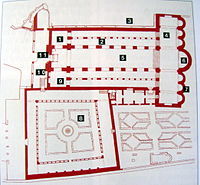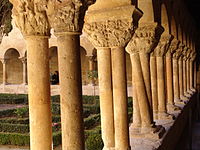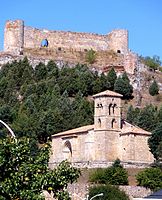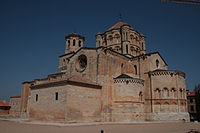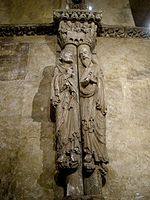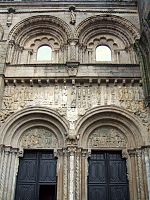Spanish Romanesque
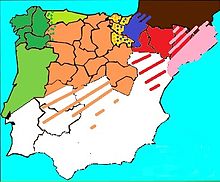
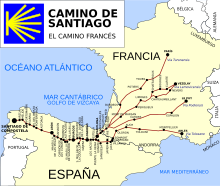
Spanish Romanesque designates the Romanesque art developed in the Hispanic-Christian kingdoms of the Iberian Peninsula in the 11th and 12th centuries. Its stylistic features are essentially common to the European Romanesque although it developed particular characteristics in the different regions of the peninsula. There is no Romanesque art in the southern half of the peninsula because it remained under Muslim rule (Al-Andalus). The examples of Romanesque buildings in the central area of the peninsula are sparse and of the latest period, with virtually no presence south of the Ebro and the Tagus. Most Romanesque buildings can be found in the northern third of the peninsula. Romanesque art was introduced into the peninsula from east to west, so scholars have usually defined regional characteristics accordingly: the "eastern kingdoms" comprising the Pyrenean areas, Catalan Romanesque, Aragonese Romanesque and Navarrese Romanesque, and the "western kingdoms" comprising Castilian-Leonese Romanesque, Asturian Romanesque, Galician Romanesque and Portuguese Romanesque.
The First Romanesque or Lombard Romanesque is specially present in Catalonia, while the full Romanesque spread from the foundations of the Order of Cluny along the axis of the Camino de Santiago. The late-romanesque of the 13th century, can be found specially in rural buildings.[1]
Architecture

From the 11th century the European artistic influence, specially from the Burgundian
The chronology in the penetration of architectural forms can be followed from east to west. The first examples are in Catalonia (
The 12th century saw the culmination of the style with:
- The Monastery of Ripoll and the churches of Boí and Taüll in Catalonia,
- Monastery of San Juan de la Peñain Aragon
- Palace of the Kings of Navarre (Estella), the church of San Miguel (Estella), Saint Mary of Eunate and Saint Peter of Olitein Navarre
- the Segovian arcaded churches, the church of Santo Domingo (Soria) and the Monastery of San Juan de Dueroin Castile,
- the Cathedral of Zamora and the Old Cathedral of Salamancain Leon.
The transition from Romanesque to Gothic starts from the late 12th century and can be seen in the
Few but notable are the churches of central plan, which are often associated with models from the Holy Land brought by the military orders. The main examples are the church of Saint Mary of Eunate in Navarre, the church of the Holy Sepulchre (Torres del Río) and the church of the Vera Cruz (Segovia).[3]
-
San Martin (Frómista).
-
Santa Maria la Mayor (Toro).
-
Cathedral of Santiago de Compostela.
Sculpture
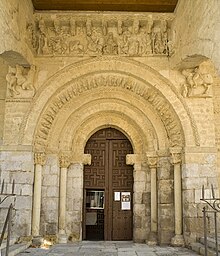




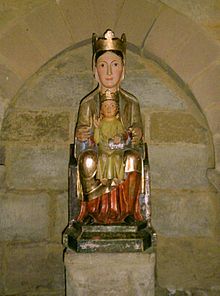

The earliest works of
The most outstanding examples from the 12th century are the façades of

The round bulge carvings that have been preserved in polychrome wood usually depict either the Christ crucified in the type called Majesty or the Madonna with Child in the type called sedes sapientiae ("Seat of Wisdom"). An exceptional sculptural group is the Davallament of Sant Joan de les Abadesses, which shows the transition to the Gothic style.[6]

Painting
Spanish Romanesque can boast some outstanding frescoes such as the Pantheon of the Kings of San Isidoro (León), retained 'in situ', or those removed from their original locations such as

Panel painting produced
-
Front of Seu d'Urgell or of the Apostle
-
Front Avià.
Sumptuary arts
The preparation of manuscripts in the monasteries and cathedrals
Some excellent examples of textiles from liturgical vestments and tapestries have survived such as the Tapestry of Creation of the Cathedral of Girona.
The Ivory carving of Andalusian influence developed an important workshop at the Leonese court.
Areas
- Examples ordered geographically, from east to west
-
Frescos deSant Climent de Taüll.
-
Tower and apses of Sant Climent de Taüll.
-
Portico of the church of Santa Maria de Ripoll.
-
Facade and towers of Ripoll.
-
Apses and dome of Ripoll.
-
Cloister of Ripoll.
-
San Juan de la Peña.
-
Western Front of theCathedral of Jaca.
-
Castle of Loarre.
-
Church-castle ofUjué.
-
Cloister of Santo Domingo de Silos.
-
The doubt of St. Thomas, in the cloister of Silos.
-
Santo Domingo (Soria).
-
Central column of San Baudelio de Berlanga.
-
The Weddings at Cana, fresco of San Baudelio de Berlanga.
-
Tomb of the Holy Brothers Martyrs in thebasilica of San Vicente (Ávila).
-
Santa María la Mayor of Arévalo (Romanesque-Mudéjar).
-
San Andrés de Cuéllar (Romanesque-Mudéjar).
-
Tower and atrium of San Esteban (Segovia).
-
Interior of the Church of la Vera Cruz (Segovia).
-
San Martín de Frómista.
-
Corbels in theCollegiate of San Pedro de Cervatos.
-
Cloister of the Collegiate church of Santa Juliana (Santillana del Mar).
-
Colegiata de Santa María la Mayor (Toro).
-
Dome of theOld Cathedral (Salamanca).
-
San Román (Toledo) (Romanesque-Mudéjar).
-
San Lorenzo (Sahagún) (Romanesque-Mudéjar).
-
Royal Pantheon ofSan Isidoro (León).
-
Two of the apostles of the Cámara Santa (Oviedo).
-
Corbels in San Martino de Villallana. -Church of San Martino de Villallana-
-
Portico of the Cathedral of Ourense.
-
Vault, clerestory and arches of the central nave of theCathedral of Santiago de Compostela.
-
Facade of Pratarías of the Cathedral of Santiago de Compostela.
-
Codex Calixtinus, 1140.
See also
References
- ISBN 9788431625542, cp. 9, pg. 145-165.
- ^ Juan Haro, op. cit.
- ^ Raquel Gallego, Historia del Arte, Editex, 2009, pg. 188
- ^ Ficha en Artehistoria Archived 2013-12-14 at the Wayback Machine
- ^ Juan Haro, op. cit.; Raquel Gallego, op. cit., pg. 189 y ss.
- ^ Raquel Gallego, op. cit, pg. 192.
- ^ Juan Haro, ``op. cit.
- ^ Raquel Gallego, op. cit., pg. 196
- ^ Virtual tour: THE GOBLET OF DOÑA URRACA, pious donation of the Queen of Zamora
- ^ Raquel Gallego, op. cit., pg. 197-198.

